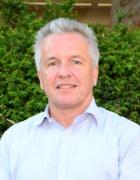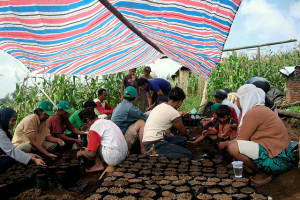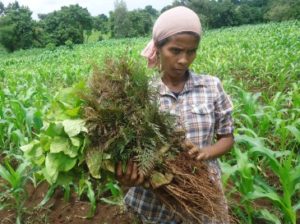
Before the start of the second phase of the CGIAR Research Program on Forests, Trees and Agroforestry (FTA), Tony Simons, Director General of the World Agroforestry Centre (ICRAF) gave us his take on the achievements of the program, some challenges and why partnerships are key to success. Read more stories on partnerships here.
Looking back at the first phase of the CGIAR Research Program on Forests, Trees and Agroforestry (FTA), how would you assess its success?
You can fund research in three ways, at project, program or at an institutional level. In the past, donors had been focused on organizations, so there was core funding to centers, to legal entities. And then people got a bit nervous about that and they jumped to projects.
So when we started FTA the world was very focused on projects. But one of the problems of jumping to projects is that you end up with a very fragmented agenda, very dispersed, hard to connect. So the programmatic approach that straddles the project and institutional one was seen as a next stage in that evolution. And I think that was largely a good approach.
Also read: Diversity, commitment, challenges and shared goals: How CIRAD looks at FTA
When ICRAF started constructing the program in 2010, together with the Center for International Forestry Research (CIFOR) and others, we decided to put about two thirds of our research into that one CGIAR Research Program. CIFOR put 100 percent of its effort into FTA, and we wanted to match them financially so that it became a true partnership.
I think that the evolution of the program, of the contents, of the priorities has gone very smoothly. While identifying what those priorities are there wasn’t a lot of arm-wrestling about what was really important.
Because forestry and agroforestry and the perennial landscape issues that we address are long term, you can’t keep chopping and changing. It has to be a longer-term program. That has been really good.

CIFOR’s Deputy Director General Robert Nasi has done a fantastic job as FTA Director in the first phase. He’s been very sensitive to institutional issues, he has been very open with sharing information, he has been very careful to not overpromote CIFOR. And it’s good that we now have a website that no longer starts with www.cifor…, but is dedicated to FTA exclusively.
We’re enthusiastic about the next phase of FTA research. We are committed to it. And we want to make it a success. We will continue with our high-profile work on Livelihood Systems, (now called Flagship 1, in the next phase running as Flagship 2), which is already 85 percent funded from bilateral sources. Bilateral funding partners strongly support the work and want to see it happen.
So what was really important in research on forests, trees and agroforestry, what stands out for you from the past five years?
If we look at the global Gross Domestic Product, four percent is agriculture, one percent is forestry. And yet the investment in forestry is very low.
The UN Forum on Forests indicated that we need between 100 and 200 billion dollars a year to achieve sustainable forest management in all its forms, natural forests, plantations, trees on farms and savannah tree cover. So that’s a huge gap.
Also read: Robert Nasi: Partnerships make forests, trees and agroforestry program work
FTA is the world’s largest research program on forests, trees and agroforestry, with the largest expertise, with the greatest legacy of publications, with the widest network of partners in the developing world. This is a fantastic opportunity to work towards global goals.
The incremental investments in our research program have not been overwhelming but they’ve been a useful trigger to change behaviour, to change attitudes, to leverage a lot of the previously fragmented work.
I think being part of this large research program has also given people another way of describing their work, articulating their work. And although we could do a better job in branding ourselves as FTA, the researchers within the program are actually very proud of it.
In a way it’s like scientists without borders, without being constrained by institutional issues.

What were the challenges in the partnership?
We’ve faced challenges when it comes to the allocation of discretionary funding. So the Steering Committee were very wise when they empowered the Flagship leaders. A relatively small amount of the budget is used for management support and other central issues. Most of the discretionary funding is put into the hands of the middle managers and the decisions are made at that level. This is how we could overcome this challenge.
We were a little slow in developing performance matrices, asking what does success actually look like? How do we reward those who are over-performing and assist those who are under-performing? Often turning off the supply of money is not the best way of raising performance.
There has been an asymmetry between partners’ contribution. The big ones, CIFOR and ICRAF have put in 10 to 20 times more than the smaller partners, around 90 percent of the total resources. This means additional bilateral resources, and projects and teams and staff and facilities and datasets that people are bringing into the program.
CIRAD puts in a lot in kind, i.e. fully paid staff in the projects, but this doesn’t flow through the budget.
This has to do with the fact that the original four partners took different approaches when the 15 CGIAR Research Programs were created in 2011. ICRAF signed up for six of them, with FTA as the largest.
Other centers signed up for many more programs, which means that they had to spread out their money over this larger number. So they are much more reliant on the discretionary resources from FTA but were not able, understandably, to deliver at the same level as the bigger partners. Of course, with a smaller contribution, how much attention do you pay to the program?

Which partnerships within FTA worked best and why so?
Partnerships work best when they are among equals. That is quite different from just subcontracting someone to do some work for you. So partnerships are about long-term relationships, about recognizing the strength of others, about respecting them, valuing them.
The partnerships that have worked well within FTA are the ones where people have voluntarily brought in resources to join efforts and enthusiastically worked together. The Agroforestry and Forestry in Sulawesi: Linking Knowledge with Action (AgFor) project is a good example.
It all comes down to scientists voting with their time. If they see the benefit of working together they will collaborate, it doesn’t have to do with how many emails senior leadership sends. But if they’re not convinced of the logic of it, it doesn’t matter how much you try and coerce them: it’s not going to happen.
The partnerships were good that have been able to bring in people from outside the CGIAR, because the Research Programs are not just about the CG system. Bringing CIRAD and CATIE into the Steering Committee has helped to open up the program.
I also want to mention the collaboration with the University of Copenhagen on germplasm research, because that was based on 40 years of support from DANIDA, so we’re harvesting that legacy.
What kind of partnerships do you want to put more emphasis on in the next phase?
It is always important to bring in new partners. All partnerships are equally valuable, because we need all of them, researchers, implementers, governments, and more and more the private sector. CIFOR and ICRAF are about to sign a Memorandum of Understanding with Asia Pulp and Paper on bringing agroforestry into forest concession areas.
ICRAF works a lot with the private sector, one third of the private money that comes into the CGIAR goes directly to ICRAF. There’s a growing awareness within the CG, and among the scientists, of how one can combine public goods with private interests in a beneficial way.
There could be policies that FTA adopts as well. FTA is not a legal entity, but it still could have policies on environmental safeguards, social safeguards, private sector engagement. ICRAF was the first CG center to have a private sector engagement policy.
Let’s look ahead 20, 30, 40 years, we want people to say that the changes that took place in the early 2000s triggered a greater recognition and impact of the work on forestry and agroforestry. This is why we need strong partnerships.
Robert Nasi: Partnerships make forests, trees and agroforestry program work
Long-term relationships and mutual trust—partnerships and research on climate change
The best science is nothing without local voices: Partnerships and landscapes
Influence flows both ways: Partnerships are key to research on Livelihood systems
Alignment is key to make partnerships work
Long-term partnerships benefit research on tree genetic resources











